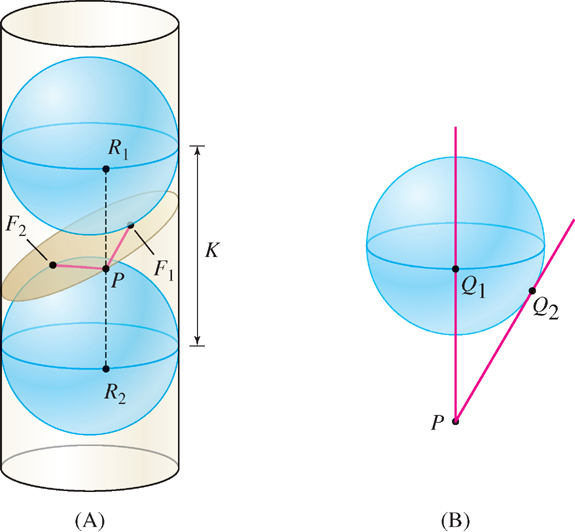Further Insights and Challenges
Question 13.47
Sketch the curve parametrized by r(t) = 〈|t|+ t, |t|− t〉.
Question 13.48
Find the maximum height above the xy-plane of a point on r(t) = 〈et, sin t, t (4 − t)〉.
Question 13.49
 Let
Let  be the curve obtained by intersecting a cylinder of radius r and a plane. Insert two spheres of radius r into the cylinder above and below the plane, and let F1 and F2 be the points where the plane is tangent to the spheres [Figure 16(A)]. Let K be the vertical distance between the equators of the two spheres. Rediscover Archimedes’s proof that
be the curve obtained by intersecting a cylinder of radius r and a plane. Insert two spheres of radius r into the cylinder above and below the plane, and let F1 and F2 be the points where the plane is tangent to the spheres [Figure 16(A)]. Let K be the vertical distance between the equators of the two spheres. Rediscover Archimedes’s proof that  is an ellipse by showing that every point P on
is an ellipse by showing that every point P on  satisfies
satisfies


Hint: If two lines through a point P are tangent to a sphere and intersect the sphere at Q1 and Q2 as in Figure 16(B), then the segments  and
and  have equal length. Use this to show that PF1 = PR1 and PF2 = PR2.
have equal length. Use this to show that PF1 = PR1 and PF2 = PR2.
Question 13.50
Assume that the cylinder in Figure 16 has equation x2 + y2 = r2 and the plane has equation z = ax + by. Find a vector parametrization r(t) of the curve of intersection using the trigonometric functions cos t and sin t.
Question 13.51
 Now reprove the result of Exercise 43 using vector geomentry. Assume that the cylinder has equation x2 + y2 = r2 and the plane has equation z = ax + by.
Now reprove the result of Exercise 43 using vector geomentry. Assume that the cylinder has equation x2 + y2 = r2 and the plane has equation z = ax + by.
731
Show that the upper and lower spheres in Figure 16 have centers

Show that the points where the plane is tangent to the sphere are

Hint: Show that  and
and  have length r and are orthogonal to the plane.
have length r and are orthogonal to the plane.
Verify, with the aid of a computer algebra system, that Eq. (2) holds with

To simplify the algebra, observe that since a and b are arbitrary, it suffices to verify Eq. (2) for the point P = (r, 0, ar).